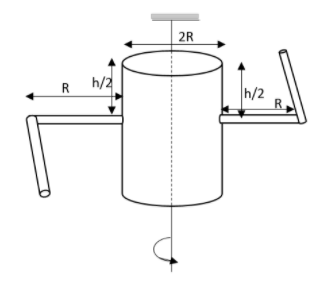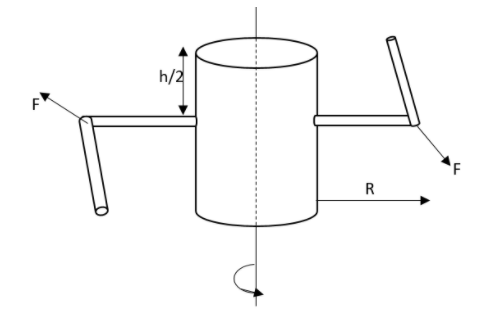
let us assume that a cylindrical container of radius $R$ and height $h$ is fully filled with a liquid. It has been connected to two horizontal $L$ shaped pipes having a small cross-sectional area $a$ to the cylinder as shown in the diagram. Now let us assume that these two pipes are opened and fluid begins to come out of the pipes horizontally in opposite directions. Then what will be the torque due to ejected liquid on the system?

$\begin{align}
& A.4agh\rho R \\
& B.8agh\rho R \\
& C.2agh\rho R \\
& D.\text{none of these} \\
\end{align}$

Answer
558.3k+ views
Hint: The velocity of efflux of water can be found by taking the square root of twice the product of the acceleration due to gravity and the height of the liquid. Here the force on the ejected water will be equivalent to the rate of variation of momentum of the ejected water. This will help you in answering this question.
Complete step by step answer:
the velocity of efflux of water can be found by taking the square root of twice the product of the acceleration due to gravity and the height of the liquid. Here the height of the liquid can be shown as,
$h\to \dfrac{h}{2}$
This can be written as,
$V=\sqrt{2g\dfrac{h}{2}}=\sqrt{gh}$
Here the force on the ejected water will be equivalent to the rate of variation of momentum of the ejected water.
That is,
$F=\rho a{{V}^{2}}$
Where $\rho $be the density of liquid, $a$ be the cross sectional area and $V$be the velocity of efflux.
Therefore the torque of these forces about the central line will be equivalent to,
$\tau =\left( \rho a{{V}^{2}} \right)\times 4R$
Simplifying this equation can be done as,
$\tau =4\rho a{{V}^{2}}R$
Substituting the velocity of efflux in the equation can be shown as,
$\tau =4\rho aghR$
Hence the torque due to ejected liquid on the system has been obtained.

So, the correct answer is “Option A”.
Note: Velocity of efflux is not dependable on the size of orifice. The density of the fluid will be actually changing with depth for greater heights. In such situations, the velocity of efflux will be dependable on the density of the liquid.
Complete step by step answer:
the velocity of efflux of water can be found by taking the square root of twice the product of the acceleration due to gravity and the height of the liquid. Here the height of the liquid can be shown as,
$h\to \dfrac{h}{2}$
This can be written as,
$V=\sqrt{2g\dfrac{h}{2}}=\sqrt{gh}$
Here the force on the ejected water will be equivalent to the rate of variation of momentum of the ejected water.
That is,
$F=\rho a{{V}^{2}}$
Where $\rho $be the density of liquid, $a$ be the cross sectional area and $V$be the velocity of efflux.
Therefore the torque of these forces about the central line will be equivalent to,
$\tau =\left( \rho a{{V}^{2}} \right)\times 4R$
Simplifying this equation can be done as,
$\tau =4\rho a{{V}^{2}}R$
Substituting the velocity of efflux in the equation can be shown as,
$\tau =4\rho aghR$
Hence the torque due to ejected liquid on the system has been obtained.

So, the correct answer is “Option A”.
Note: Velocity of efflux is not dependable on the size of orifice. The density of the fluid will be actually changing with depth for greater heights. In such situations, the velocity of efflux will be dependable on the density of the liquid.
Recently Updated Pages
Why are manures considered better than fertilizers class 11 biology CBSE

Find the coordinates of the midpoint of the line segment class 11 maths CBSE

Distinguish between static friction limiting friction class 11 physics CBSE

The Chairman of the constituent Assembly was A Jawaharlal class 11 social science CBSE

The first National Commission on Labour NCL submitted class 11 social science CBSE

Number of all subshell of n + l 7 is A 4 B 5 C 6 D class 11 chemistry CBSE

Trending doubts
What is meant by exothermic and endothermic reactions class 11 chemistry CBSE

10 examples of friction in our daily life

One Metric ton is equal to kg A 10000 B 1000 C 100 class 11 physics CBSE

1 Quintal is equal to a 110 kg b 10 kg c 100kg d 1000 class 11 physics CBSE

Difference Between Prokaryotic Cells and Eukaryotic Cells

What are Quantum numbers Explain the quantum number class 11 chemistry CBSE




